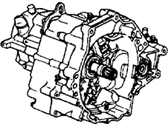×
- Live Chat
- 1-888-984-2011

My Garage
My Account
Cart
Genuine Honda CRX Transmission Assembly
Trans Assembly- Select Vehicle by Model
- Select Vehicle by VIN
Select Vehicle by Model
orMake
Model
Year
Select Vehicle by VIN
For the most accurate results, select vehicle by your VIN (Vehicle Identification Number).
32 Transmission Assemblies found
Honda CRX Transmission Assembly (Gw-010)
Part Number: 20011-PE6-690$2885.62 MSRP: $3843.65You Save: $958.03 (25%)
| Page 1 of 2 |Next >
1-20 of 32 Results
Honda CRX Transmission Assembly
In search of affordable OEM Honda CRX Transmission Assembly? Consider browsing through our extensive inventory of genuine Honda CRX Transmission Assembly. Not only do we provide market-leading prices and a manufacturer's warranty, but we also pride ourselves on exceptional customer service and swift delivery.
Honda CRX Transmission Assembly Parts Questions & Experts Answers
- Q: How do you remove and install the automatic transaxle on Honda CRX?A: To bring the nut of the transaxle bolt into position for removal and to install the new transaxle, it is necessary to disconnect the battery cables and to remove the battery then to raise and to safely support the vehicle. Undo the three screws on the mount and a screw near to the side of the battery base and the intake hose band of the throttle body, later undid the air cleaner case together with the intake hose. Subsequently, take off the starter solvent and transaxle ground cable, and the lock-up control solenoid valve wire connector. For 4WD Civic Wagon models, in addition: Shift control solenoid valve wire connectors; Automatic transaxle speed pulser connector. Remove the control cable from the control lever and then remove the transaxle fill plug and drain the fluid But before doing so replace the drain plug washer too. Starting from the hoses to the cooler, disconnect and plug them and then put a marker on the distributor housing position and also remove the distributor. Take off shift cable, speedometer cable and, in case with 4WD models, the driveshaft. Loosen and disconnect all the torque converter cover and driveplate bolts while simultaneously rotating the crankshaft pulley, after this remove the engine splash sheet and the right wheel well splash sheet and then remove header pipe. Remove right ball joints, take out the right radius rod, and get the right and left half-shafts off as well as the intermediate shaft, if it is a 4WD variant. The transaxle cover has to be detached, and if the engine is to be lifted just enough to unload the mounts, then the transaxle also needs be lifted just enough to be off its mounts. Disconnect and take out the transaxle mounting bolts and the front and rear transaxle mount brackets and pull the transaxle backwards from the engine. For installation, there should be dowel pins fitted into place, the transaxle should be lifted to this position, the transaxle-to-cylinder bolts should be fitted loosely then tightened to the specified torque. Place the side of the engine, rear of the transaxle and front and side of the transaxle then fasten the engine side mounting bolt, the rear transaxle mount bracket and the fasteners of transaxle mount to the required torque. Take off the transaxle jack, tighten the side engine mount bolt for the 4WD models and fasten the torque converter on the driveplate with the following bolts in a diagonal fashion. Replace it with shift cable, torque cover and header pipe bracket, transaxle cover and intermediate shaft for 4-wheel drive model. To do this, new set rings are introduced on the halfshafts that gets slid over the axles of the Differential while at the same time fitting the damper fork bolt and radius rod. Refit the ball joints and screw the nuts tightly, and reinstall the driveshaft for 4 WD vehicles. Last step is to put back the splash shields, distributor and reconnect all the required cables and hoses tightening them to the proper recommended torque. Lower the vehicle, install the battery proper, filled the transaxle with the fluid and test it by engage the engine and shifting through all the gears possible.










